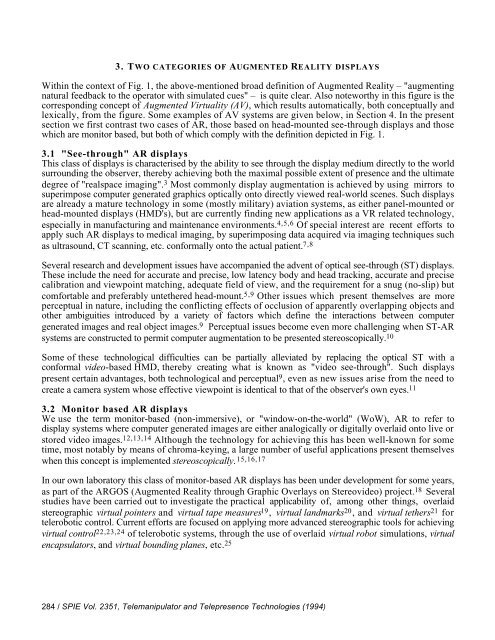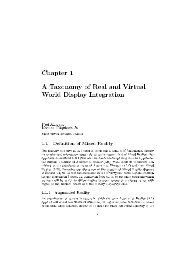Augmented Reality: A class of displays on the reality-virtuality ...
Augmented Reality: A class of displays on the reality-virtuality ...
Augmented Reality: A class of displays on the reality-virtuality ...
Create successful ePaper yourself
Turn your PDF publications into a flip-book with our unique Google optimized e-Paper software.
3. TWO CATEGORIES OF AUGMENTED REALITY DISPLAYSWithin <strong>the</strong> c<strong>on</strong>text <str<strong>on</strong>g>of</str<strong>on</strong>g> Fig. 1, <strong>the</strong> above-menti<strong>on</strong>ed broad definiti<strong>on</strong> <str<strong>on</strong>g>of</str<strong>on</strong>g> <str<strong>on</strong>g>Augmented</str<strong>on</strong>g> <str<strong>on</strong>g>Reality</str<strong>on</strong>g> – "augmentingnatural feedback to <strong>the</strong> operator with simulated cues" – is quite clear. Also noteworthy in this figure is <strong>the</strong>corresp<strong>on</strong>ding c<strong>on</strong>cept <str<strong>on</strong>g>of</str<strong>on</strong>g> <str<strong>on</strong>g>Augmented</str<strong>on</strong>g> Virtuality (AV), which results automatically, both c<strong>on</strong>ceptually andlexically, from <strong>the</strong> figure. Some examples <str<strong>on</strong>g>of</str<strong>on</strong>g> AV systems are given below, in Secti<strong>on</strong> 4. In <strong>the</strong> presentsecti<strong>on</strong> we first c<strong>on</strong>trast two cases <str<strong>on</strong>g>of</str<strong>on</strong>g> AR, those based <strong>on</strong> head-mounted see-through <str<strong>on</strong>g>displays</str<strong>on</strong>g> and thosewhich are m<strong>on</strong>itor based, but both <str<strong>on</strong>g>of</str<strong>on</strong>g> which comply with <strong>the</strong> definiti<strong>on</strong> depicted in Fig. 1.3.1 "See-through" AR <str<strong>on</strong>g>displays</str<strong>on</strong>g>This <str<strong>on</strong>g>class</str<strong>on</strong>g> <str<strong>on</strong>g>of</str<strong>on</strong>g> <str<strong>on</strong>g>displays</str<strong>on</strong>g> is characterised by <strong>the</strong> ability to see through <strong>the</strong> display medium directly to <strong>the</strong> worldsurrounding <strong>the</strong> observer, <strong>the</strong>reby achieving both <strong>the</strong> maximal possible extent <str<strong>on</strong>g>of</str<strong>on</strong>g> presence and <strong>the</strong> ultimatedegree <str<strong>on</strong>g>of</str<strong>on</strong>g> "realspace imaging". 3 Most comm<strong>on</strong>ly display augmentati<strong>on</strong> is achieved by using mirrors tosuperimpose computer generated graphics optically <strong>on</strong>to directly viewed real-world scenes. Such <str<strong>on</strong>g>displays</str<strong>on</strong>g>are already a mature technology in some (mostly military) aviati<strong>on</strong> systems, as ei<strong>the</strong>r panel-mounted orhead-mounted <str<strong>on</strong>g>displays</str<strong>on</strong>g> (HMD's), but are currently finding new applicati<strong>on</strong>s as a VR related technology,especially in manufacturing and maintenance envir<strong>on</strong>ments. 4,5,6 Of special interest are recent efforts toapply such AR <str<strong>on</strong>g>displays</str<strong>on</strong>g> to medical imaging, by superimposing data acquired via imaging techniques suchas ultrasound, CT scanning, etc. c<strong>on</strong>formally <strong>on</strong>to <strong>the</strong> actual patient. 7,8Several research and development issues have accompanied <strong>the</strong> advent <str<strong>on</strong>g>of</str<strong>on</strong>g> optical see-through (ST) <str<strong>on</strong>g>displays</str<strong>on</strong>g>.These include <strong>the</strong> need for accurate and precise, low latency body and head tracking, accurate and precisecalibrati<strong>on</strong> and viewpoint matching, adequate field <str<strong>on</strong>g>of</str<strong>on</strong>g> view, and <strong>the</strong> requirement for a snug (no-slip) butcomfortable and preferably unte<strong>the</strong>red head-mount. 5,9 O<strong>the</strong>r issues which present <strong>the</strong>mselves are moreperceptual in nature, including <strong>the</strong> c<strong>on</strong>flicting effects <str<strong>on</strong>g>of</str<strong>on</strong>g> occlusi<strong>on</strong> <str<strong>on</strong>g>of</str<strong>on</strong>g> apparently overlapping objects ando<strong>the</strong>r ambiguities introduced by a variety <str<strong>on</strong>g>of</str<strong>on</strong>g> factors which define <strong>the</strong> interacti<strong>on</strong>s between computergenerated images and real object images. 9 Perceptual issues become even more challenging when ST-ARsystems are c<strong>on</strong>structed to permit computer augmentati<strong>on</strong> to be presented stereoscopically. 10Some <str<strong>on</strong>g>of</str<strong>on</strong>g> <strong>the</strong>se technological difficulties can be partially alleviated by replacing <strong>the</strong> optical ST with ac<strong>on</strong>formal video-based HMD, <strong>the</strong>reby creating what is known as "video see-through". Such <str<strong>on</strong>g>displays</str<strong>on</strong>g>present certain advantages, both technological and perceptual 9 , even as new issues arise from <strong>the</strong> need tocreate a camera system whose effective viewpoint is identical to that <str<strong>on</strong>g>of</str<strong>on</strong>g> <strong>the</strong> observer's own eyes. 113.2 M<strong>on</strong>itor based AR <str<strong>on</strong>g>displays</str<strong>on</strong>g>We use <strong>the</strong> term m<strong>on</strong>itor-based (n<strong>on</strong>-immersive), or "window-<strong>on</strong>-<strong>the</strong>-world" (WoW), AR to refer todisplay systems where computer generated images are ei<strong>the</strong>r analogically or digitally overlaid <strong>on</strong>to live orstored video images. 12,13,14 Although <strong>the</strong> technology for achieving this has been well-known for sometime, most notably by means <str<strong>on</strong>g>of</str<strong>on</strong>g> chroma-keying, a large number <str<strong>on</strong>g>of</str<strong>on</strong>g> useful applicati<strong>on</strong>s present <strong>the</strong>mselveswhen this c<strong>on</strong>cept is implemented stereoscopically. 15,16,17In our own laboratory this <str<strong>on</strong>g>class</str<strong>on</strong>g> <str<strong>on</strong>g>of</str<strong>on</strong>g> m<strong>on</strong>itor-based AR <str<strong>on</strong>g>displays</str<strong>on</strong>g> has been under development for some years,as part <str<strong>on</strong>g>of</str<strong>on</strong>g> <strong>the</strong> ARGOS (<str<strong>on</strong>g>Augmented</str<strong>on</strong>g> <str<strong>on</strong>g>Reality</str<strong>on</strong>g> through Graphic Overlays <strong>on</strong> Stereovideo) project. 18 Severalstudies have been carried out to investigate <strong>the</strong> practical applicability <str<strong>on</strong>g>of</str<strong>on</strong>g>, am<strong>on</strong>g o<strong>the</strong>r things, overlaidstereographic virtual pointers and virtual tape measures 19 , virtual landmarks 20 , and virtual te<strong>the</strong>rs 21 fortelerobotic c<strong>on</strong>trol. Current efforts are focused <strong>on</strong> applying more advanced stereographic tools for achievingvirtual c<strong>on</strong>trol 22,23,24 <str<strong>on</strong>g>of</str<strong>on</strong>g> telerobotic systems, through <strong>the</strong> use <str<strong>on</strong>g>of</str<strong>on</strong>g> overlaid virtual robot simulati<strong>on</strong>s, virtualencapsulators, and virtual bounding planes, etc. 25284 / SPIE Vol. 2351, Telemanipulator and Telepresence Technologies (1994)




